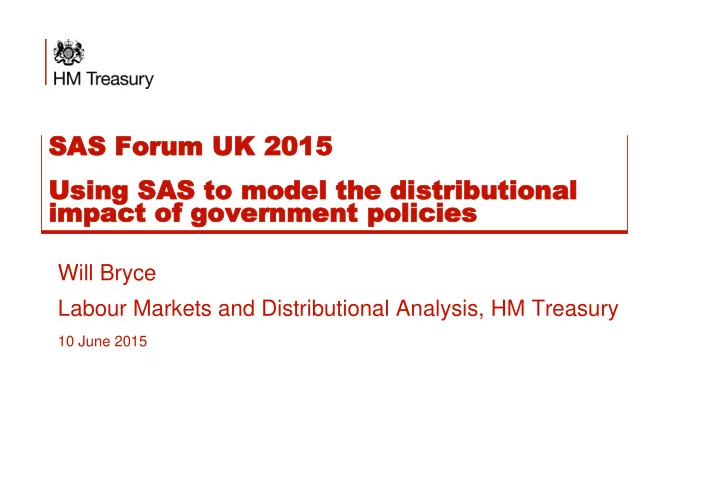

SAS SAS Fo Foru rum m UK UK 20 2015 15 Using Us ing SA SAS S to to mo mode del l th the d e distr istribu ibutio tiona nal l impac impact t of gov of gover ernme nment nt po poli licies cies Will Bryce Labour Markets and Distributional Analysis, HM Treasury 10 June 2015
About us • Labour Markets and Distributional Analysis team in HM Treasury • Advises ministers on the distributional implications of tax and public spending policies. • How would a cut in income tax benefit households at different points across the income distribution? What about different household types? • Since 2010, we have also published regular analysis of the cumulative impact of the government’s policies (e.g. fiscal consolidation) on households, across the income and expenditure distributions. • First analysis of tax and welfare measures published in the June 2010 Budget, then updated at biannual fiscal events (March Budget and Autumn Statement) and the less frequent Spending Reviews 2
Budget 2015 chart 3
30 years of microsimulation modelling of the tax and benefit system The team uses HM Treasury’s I ntra- Go vernmental T ax and Benefit • M odel (IGOTM) – a non-behavioural, static microsimulation model in use since the 1980s. The current version (IGOTM2) has been in use since 2001 and successive governments have been using it to inform key policy decisions since. • One of a number of government microsimulation models, such as DWP’s Policy Simulation Model (PSM), though only IGOTM can model the impact of indirect taxes (e.g. VAT, duties) and benefits in kind (e.g. spending on the NHS). • Model used to be jointly owned with several other government departments e.g. HMRC and the Department for Communities and Local Government, but now sits solely within HMT. 4
What is IGOTM? An input dataset and series of SAS modules (called ‘ costings ’) • modelling a wide range of taxes, benefits and benefits in kind from public services, all run through a central ‘Control’ module behind a front-end. Underlying dataset is the ONS’s Living Costs and Food Survey (LCF), • an annual survey capturing detailed information on household incomes and expenditure. Sample size approx. 13,000 individuals (6,000 households) – we pool 3 years together to improve robustness. • IGOTM uses this data to microsimulate direct and indirect taxes as well as means tested benefits and tax credits. ‘Running’ a costing requires the creation and manipulation of a large • number of big datasets, which SAS allows us to do quickly. We also use SAS to produce the detailed statistical breakdowns needed for follow-up analysis. 5
IGOTM 6
IGOTM – ‘running a costing’ • Three main stages: • Initial manipulation of the base ONS data – due to small samples we merge 3 years of LCF data, then rename, recalculate and recode data so it’s ready to use. • Uprating earnings, rents, benefit levels etc. in the dataset to the year being modelled, using official economic forecasts. • We use this uprated dataset of circumstances, incomes, and expenditure to simulate the taxes paid and benefits received of households in the base data. Add this up for all households in the model – once for the • ‘counterfactual’ year (e.g. 2015-16 under the previous government’s policies) and once for the policy year (e.g. 2015-16 under the current government’s policies) – and compare. 7
Tax and welfare modelling diagram 3 years of LCF (10/11-11/12-12/13) Adjust earnings, benefits etc. for inflation to 15/16 IGOTM input data COUNTER (in 15/16 prices) ACTUAL -FACTUAL Simulate in IGOTM ‘previous Simulate in IGOTM government’s’ tax & actual tax & benefit benefit system as it system in 2015/16 would be in 2015/16 IGOTM output data, with IGOTM output data, with incomes, benefits and incomes, benefits and Compare taxes reflecting previous taxes reflecting current incomes government’s system government’s system 8
Example: income tax • Fred appears in the Living Costs and Food Survey dataset. He is 40 (working age) and single with no children. He earns £30,000 per year from employment, and has no other income. We’re modelling 2015 -16, so the personal allowance is £10,600, the higher rate • threshold is £42,385, and the basic tax rate is 20% under government policy. • That means that Fred has £19,400 (£30,000 - £10,600) of taxable income, all taxable at 20%, so he pays £3,880 in income tax. Under the last government’s rules, the (counterfactual) personal allowance would • have been £7,775 in 2015-16, the higher rate threshold £52,775, and the tax rate 20%. • So in the counterfactual Fred has £22,225 of taxable income, all taxable at 20%, and so pays £4,445 in income tax. • Looking only at the change to the personal allowance, Fred is £565 better off in the policy world compared to the counterfactual. 9
Budget 2015 chart 10
Modernising IGOTM Last major update to IGOTM was in 2001 – starting to show its age • • Currently working with Amadeus to bring IGOTM up to date, reflecting how its use has evolved since the previous design and to improve compatibility with our current systems: • Now hosted on a remote server • New user interface – cleaner, faster, more modern • Better compatibility with Windows 8 • Moved from Base SAS v8 to Enterprise Guide • Additional functionality added e.g. bootstrapping to produce confidence intervals around results, and greater integration with Excel. Obsolete features removed. 11
Contact Will Bryce Labour Markets and Distributional Analysis, HM Treasury Email: william.bryce@hmtreasury.gsi.gov.uk Tel: 020 7270 5137 12
Recommend
More recommend